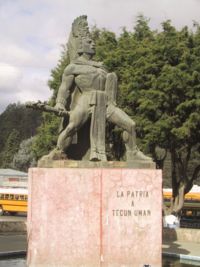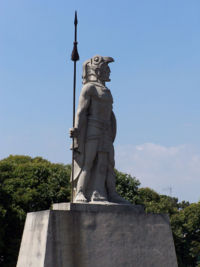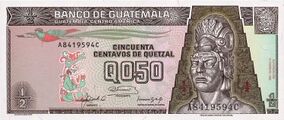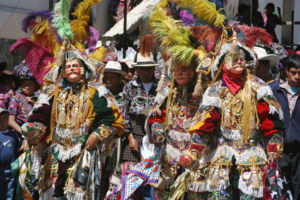Tecum Umam: Difference between revisions
imported>Joe Quick |
imported>Joe Quick |
||
| Line 40: | Line 40: | ||
One piece of evidence about Tecum Umam the historical person comes from Alvarado himself in a letter written to [[Hernán Cortés]]. The letter is quite sparing in details, however - the legend in its current form appears to have come down to us indirectly from indigenous documents that were produced some years after Alvarado's conquest through [[Francisco de Fuentes y Guzmán]], who recorded the legend toward the end of the 17th century. | One piece of evidence about Tecum Umam the historical person comes from Alvarado himself in a letter written to [[Hernán Cortés]]. The letter is quite sparing in details, however - the legend in its current form appears to have come down to us indirectly from indigenous documents that were produced some years after Alvarado's conquest through [[Francisco de Fuentes y Guzmán]], who recorded the legend toward the end of the 17th century. | ||
Alvarado's letter to Cortés is the only contemporary documentation of his possible meeting with Tecum Umam that is available to us (the earliest indigenous documents that have been discovered date to 1550 or 1560). The letter doesn't reveal very much, however. In his description of his army's arrival in K'iche' territory and the first battle that ensued, Alvarado mentions that "in this affair one of the four chiefs of the city of [[Utatlan] | Alvarado's letter to Cortés is the only contemporary documentation of his possible meeting with Tecum Umam that is available to us (the earliest indigenous documents that have been discovered date to 1550 or 1560). The letter doesn't reveal very much, however. In his description of his army's arrival in K'iche' territory and the first battle that ensued, Alvarado mentions that "in this affair one of the four chiefs of the city of [[Utatlan]] was killed, who was the captain general of all this country."<ref name="Alvarado">Pedro de Alvarado. 1969. An Account of the Conquest of Guatemala in 1524 by Pedro de Alvarado. Sedley J. Mackie, ed. New York: Kraus Reprint Co.</ref> Alvarado does not provide a name for the K'iche' captain general; nor does he mention how or by whose hand the man was killed. | ||
The K'iche' document cited by Fuentes y Guzmán, the ''Titulo del Ahpop Quecham'', is now lost, but several other indigenous documents describe the arrival of Alvarado in what would become Guatemala. Prominent among them is the ''Título K'oyoi'' which describes the battle between the Tecum Umam and Pedro de Alvarado in terms very similar to the modern legend. This document also contains the earliest known reference to the K'iche' leader as "Tecum Umam." | The K'iche' document cited by Fuentes y Guzmán, the ''Titulo del Ahpop Quecham'', is now lost, but several other indigenous documents describe the arrival of Alvarado in what would become Guatemala. Prominent among them is the ''Título K'oyoi'' which describes the battle between the Tecum Umam and Pedro de Alvarado in terms very similar to the modern legend. This document also contains the earliest known reference to the K'iche' leader as "Tecum Umam." | ||
Revision as of 16:47, 12 April 2007
Tecum Umam (also Tecún Umán or Tekum Umam) was a legendary figure of Guatemalan and K'iche' history. Raised to the status of a national hero of Guatemala, celebrated by poets and invoked in ritual and festival contexts throughout the highlands, Tecum Umam is known as the defender of the K'iche' people and a symbol of indigenous resistance because of his role in the indigenous military resistance to the Spanish conquest of his homeland.
The legendary meeting of Tecum Umam and Pedro de Alvarado
The legend of Tecum Umam tells us that he commanded the thousands of K'iche' warriors who met the army of invading Spanish and indigenous warriors under Pedro de Alvarado on the plains of El Pinar in February of 1524. In the midst of the fray, Tecum Umam and Alvarado met face to face, each with weapon in hand. Alvarado was mounted on a horse and clad in armor while Tecum Umam wore the feathers of his nagual (animal spirit counterpart), the quetzal. A battle ensued that claimed the life of the K'iche' hero.
Taking to the sky in the form of an eagle, Tecum Umam struck down Alvarado's horse believing man and animal to be one and the same. He realized his error and turned for a second attack but Alvarado's spear pierced his opponent's chest and Tecum Umam fell to the ground dead. Then a quetzal landed on the fallen hero's chest, staining its breast feathers red with blood; the bright colors of the quetzal continue to remind us today of the great deeds of Tecum Umam.
This legend is often held to be largely apocryphal[1] but it is also widely assumed to ultimately be built around the actions of a real person.[2][3] Evidence to support both claims is found in a number of indigenous and Spanish documents that have surfaced over the years. The legend's absolute accuracy notwithstanding, Tecum Umam has inspired a wide variety of activities ranging from the production of statues and poetry to the retelling of the legend in the form of folkloric dances to prayers to the defender of the K'iche' for protection.
Tecum Umam's Legacy
National Hero
Tecum Umam was declared a National Hero of Guatemalan on March 22, 1960[3] and is the only figure to have earned that title. He is celebrated annually on February 20 and is memorialized by prominent statues in Guatemala City and Quetzaltenango. Tecum Umam's namesakes include a small town in the department of San Marcos on the Guatemala-Mexico border as well as countless hotels, restaurants, and Spanish schools throughout Guatemala.
Nobel laureate Miguel Ángel Asturias memorialized the K'iche' hero in a poem that bears his name.[4] Employing Asturias' characteristic use of themes borrowed from Guatemala's indigenous cultures and his unique style of magical realism, the poem finds the seeds of liberty in the person of Tecum Umam. The poem thus elegantly reflects the broader themes of Tecum Umam's heroic status as they are expressed through a national discourse that glorifies him as the common ancestor of all Guatemalans, the embodied fusion of Spanish and Maya.[5]
A bust of the K'iche' hero is also featured on the front of Guatemala's 0.50 Quetzal bill. To the left of Tecum Umam is the Resplendent Quetzal for which the currency is named. This is the national bird of Guatemala as well as the nagual of Tecum Umam. The bird's bright red chest and the elegant tail feathers are both significant in the legend outlined above.
Tecum Umam's presence on this bill places him in the company of some of the most important figures in Guatemalan history. He joins the ranks of other national heroes and founding fathers that are featured on Guatemala's currency, among whom are Justo Rufino Barrios, a military leader in his own right and president of Guatemala from 1873 until 1885; Mariano Gálvez, chief of state of Guatemala from 1831 until 1838; and Francisco Marroquín, an early defender of the rights of indigenous peoples.
Kíche' Hero
Tecum Umam is not only an official hero of Guatemala - he is also an important figure in a number of ritual and festival contexts within the indigenous communities of Guatemala. Among the best known of these contexts is the Baile de la conquista or "Dance of the conquest" that is performed in many Maya communities as a part of the celebration for the feast day of the town's patron saint. Costumbristas also evoke Tecum Umam in several ways as a part of traditional religious practice.
The confrontation between Tecum Umam and Pedro de Alvarado is the central theme of the Guatemalan version of the baile de la conquista[6] and acts as a symbol for the much larger conflict in which they were involved. The baile de la conquista of Latin America has its roots in the Baile de los Moros or "Dance of the Moors," which commemorates the expulsion of the Moors from Spain. As in other regions of colonial Latin America, priests encouraged the performance of the Baile de la conquista (which also ends in the religious conversion of the pagans) as a way to help them convert the population to Catholicism. In Guatemala, Tecum Umam takes the place of the Moorish prince from the Baile de los Moros.
The dance reenacts the invasion led by Alvarado and the conquest of Guatemala.[7] It opens in Utatlán, the capital of the K'iche' kingdom, where Rey K'iche' (the king) receives news of the Spaniards' approach from Montezuma in the distant Aztec capital. Then the king sends his sons and daughters to Xelajuj Noj (Quetzaltenango) to recruit Tecum Umam to lead the army against the approaching foes. The following scenes depict first the K'iche' chieftains and then the Spanish officers swearing allegiance to their leaders and then climax in the battle between Alvarado and Tecum Umam.
Tecum Umam is present as a powerful agent in a number of other ritual contexts as well. The activities leading up to the Baile de la conquista that are described by Ignacio Bizarro Ujpán[6] are characteristic of these broader practices. The sacerdote Maya, a Maya shaman, first invokes the name of God and then the village's patron saint, asking their forgiveness and explaining his (and his clients') purpose. Then, one by one, he calls on Tecum Umam or others from among a host of powerful figures (i.e. Maximón or in this case, Pedro de Alvarado) who are selected for their particular domains of influence. He offers them each tragos of alcohol and the smoke of copal, candles, and tobacco. Once he is satisfied that the benefactors are pleased with his offerings, the shaman explains why he has called on them, outlining specific needs or problems and asking for protection and good fortune on behalf of his clients and himself.
Did he ever actually exist?
Tecum Umam's status as either a man or a myth is a topic of lengthy and ongoing discussion. Historical research has demonstrated with some degree of surety that the man celebrated as a national hero of Guatemala probably did not exist quite as he is presented in the legend but there is also strong evidence to suggest that this character was not simply dreamed up. Ruud W. van Akkeren[2] defines two important questions that must be addressed on this issue:
- How does Tecum Umam fit within the K'iche' power structure?
- Was there really a historic duel between Tecum Umam and Pedro de Alvarado?

Photo © by Marco Palma, used by permission.
The evidence
One piece of evidence about Tecum Umam the historical person comes from Alvarado himself in a letter written to Hernán Cortés. The letter is quite sparing in details, however - the legend in its current form appears to have come down to us indirectly from indigenous documents that were produced some years after Alvarado's conquest through Francisco de Fuentes y Guzmán, who recorded the legend toward the end of the 17th century.
Alvarado's letter to Cortés is the only contemporary documentation of his possible meeting with Tecum Umam that is available to us (the earliest indigenous documents that have been discovered date to 1550 or 1560). The letter doesn't reveal very much, however. In his description of his army's arrival in K'iche' territory and the first battle that ensued, Alvarado mentions that "in this affair one of the four chiefs of the city of Utatlan was killed, who was the captain general of all this country."[8] Alvarado does not provide a name for the K'iche' captain general; nor does he mention how or by whose hand the man was killed.
The K'iche' document cited by Fuentes y Guzmán, the Titulo del Ahpop Quecham, is now lost, but several other indigenous documents describe the arrival of Alvarado in what would become Guatemala. Prominent among them is the Título K'oyoi which describes the battle between the Tecum Umam and Pedro de Alvarado in terms very similar to the modern legend. This document also contains the earliest known reference to the K'iche' leader as "Tecum Umam."
Tecum Umam's role in the K'iche' power structure
The meeting of Tecum Umam and Pedro de Alvarado
U b'i Tecum Umam - Tecum Umam's name
"Tecum Umam" was almost certainly not the proper name of the fallen K'iche' lord who Alvarado mentioned in his letter to Cortés, though it may have functioned as a sort of title. The earliest known appearance of this name is the Título K'oyoi which refers to the K'iche' military leader as "nima rajpop achij adelantado Tecum umam rey k'iche' don k'iq'ab'." Translated, this phrase means: "great captain general Tecum, grandson of the K'iche' king Don K'iq'ab'."
The word "umam" is not part of Tecum's name at all - it simply means "grandson of." Without a referent, it doesn't make sense. This is reinforced by the absence of a second name in early documents. Van Akkeren[2] provides several insights on this topic. He suggests that "umam" may have been given the hero as a sort of a title in reference to his noble geneology. Alternatively, van Akkeren suggests that this name may have originally been derived from another title given to the hero, "q'uq'umam," meaning "ancient one of quetzal feathers." Or it might have come from the indigenous name for a prominent local volcano: "Teyocuman."
Conclusion
While the jury is still out on the historical accuracy of the legendary Tecum Umam, this figure's influence on the modern population of Guatemala is undeniable. He is both a symbol of the state and a symbol of the peoples within the state. He is the defender of the Maya and the national hero of Guatemala. Whether in the candlelit ceremonies of the sacerdotes Mayas or in the chambers of the national congress, Tecum Umam's presence is felt in nearly every niche of the daily life of Guatemala's people.
Further reading
To learn more about some of the topics covered in this article, see Citizendium's articles about:
- Guatemala
- The K'iche' people
- Pedro de Alvarado
- The Baile de la conquista
- Maya costumbre
- The Spanish conquest of Latin America
Sources
- ↑ Ronald W. Wilhelm. 1994. Columbus's Legacy, Conquest or Invasion? An Analysis of Counterhegemonic Potential in Guatemalan Teacher Practice and Curriculum. Anthropology and Education 25(3): 173-195.
- ↑ 2.0 2.1 2.2 Ruud W. van Akkeren. 2004. Tecum Umam: ¿Personaje Mítico o Histórico? Paper presented at Ciclo de Conferencias 2004, Museo Popul Vuh, Universidad Francisco Marroquín
- ↑ 3.0 3.1 J. Daniel Contreras R. 2004. Dos guerreros indígenas. In El Memorial de Sololá y los inicios de la colonización española en Guatemala. J. Daniel Contreras R. and Jorge Luján Muñoz, eds. Pp. 65-76. Guatemala City: Academia de Geografía e Historia de Guatemala. ISBN 99922-737-1-2
- ↑ Miguel Ángel Asturias. Tecún Umán. Electronic document. Archived November 12, 2005.
- ↑ Carol Hendrickson. 1985. Guatemala - Everybody's Indian When the Occasion's Right. Cultural Survival 9(2):22-23.
- ↑ 6.0 6.1 James D. Sexton. 1992. Mayan Folktales: Folklore from Lake Atitlán, Guatemala. ISBN 0385422539.
- ↑ Barbara Bode. 1961. The Dance of the Conquest of Guatemala. New Orleans: Middle American Research Institute, Tulane University.
- ↑ Pedro de Alvarado. 1969. An Account of the Conquest of Guatemala in 1524 by Pedro de Alvarado. Sedley J. Mackie, ed. New York: Kraus Reprint Co.


